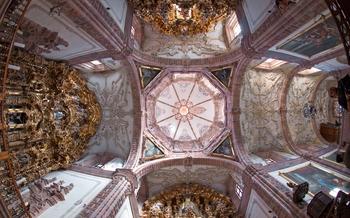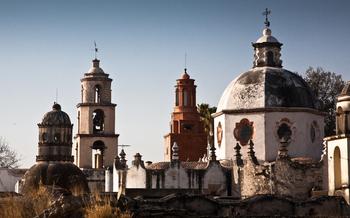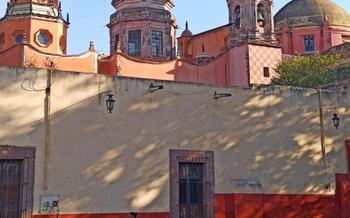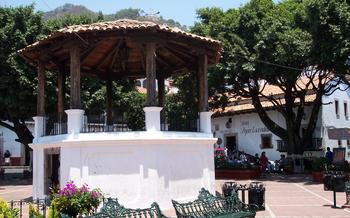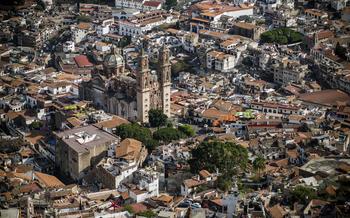
San Cayetano Church at La Valenciana
- A Baroque Masterpiece in Guanajuato: San Cayetano Church at La Valenciana
- A Journey Through Time: Historical Overview
- A Legacy of Silver: The Valenciana Mine
- Architectural Marvels: Exploring the Church's Exterior
- A Sanctuary of Art: The Church's Interior
- A Place of Worship and Devotion: Religious Significance
- A Cultural Hub: Beyond Religious Significance
- A Living Museum: Preserving the Past
- A Unique Experience: Visiting La Valenciana
- Beyond the Church: Exploring Nearby Attractions
- Capturing the Essence: Photography and Art
- Local Cuisine and Flavors: A Culinary Journey
- Shopping for Souvenirs: Bringing Home a Piece of History
- A Night to Remember: Accommodations and Atmosphere
- Insider Tip: Unveiling Hidden Secrets
A Baroque Masterpiece in Guanajuato: San Cayetano Church at La Valenciana
In the heart of Guanajuato, Mexico, stands a testament to the region's rich history and architectural prowess: the San Cayetano Church at La Valenciana. This Baroque masterpiece, often referred to as "The Valenciana," is not just an awe-inspiring sight but also holds deep religious and cultural significance for the community. Built in the 18th century amidst the opulence of the silver mining era, the church's grand facade, intricate carvings, and stunning interior frescoes narrate tales of faith, devotion, and the enduring spirit of Guanajuato.
Situated on a hillside overlooking the city, the San Cayetano Church commands attention with its imposing presence. Its location, once part of the Valenciana silver mine complex, adds to its historical significance, weaving the church's story into the fabric of Guanajuato's mining heritage. The surrounding area, dotted with colonial-era buildings and narrow cobblestone streets, provides a glimpse into the city's vibrant past, making a visit to La Valenciana a truly immersive experience.
A Journey Through Time: Historical Overview
The San Cayetano Church at La Valenciana is a testament to the rich and complex history of Guanajuato, Mexico. Its origins can be traced back to the pre-Hispanic era, when the area was inhabited by the indigenous Otomí people.
The arrival of the Spanish in the 16th century marked a turning point in the region's history. The discovery of silver in the nearby Valenciana mine led to a mining boom that transformed the area into one of the most important silver-producing regions in the world.
The construction of the San Cayetano Church was directly influenced by the wealth generated by the mining industry. In 1765, the wealthy mine owner Antonio de Obregón y Alcocer commissioned the construction of the church as a symbol of his devotion to the patron saint of miners, San Cayetano.
The church was designed by the renowned architect Francisco Eduardo Tresguerras, who incorporated elements of both Baroque and Neoclassical styles. The construction took over 30 years to complete, and the church was finally consecrated in 180
Over the centuries, the San Cayetano Church has undergone several renovations and modifications. It has survived earthquakes, fires, and political upheavals, standing as a testament to the resilience of the Mexican people.
The church's historical significance extends beyond its religious importance. It has served as a community center, a refuge during times of conflict, and a symbol of cultural identity for the people of Guanajuato.
Today, the San Cayetano Church at La Valenciana is a UNESCO World Heritage Site and a must-visit destination for anyone interested in the history, architecture, and culture of Mexico.
A Legacy of Silver: The Valenciana Mine
The Valenciana mine, located in the heart of Guanajuato, played a pivotal role in shaping the city's history and economy. Discovered in the 16th century, it quickly became one of the richest silver mines in the world, transforming Guanajuato into a thriving mining center. The mine's immense wealth fueled the city's growth and development, attracting fortune seekers and laborers from across the region.
Mining techniques employed at Valenciana were advanced for their time. Miners used a combination of hand tools, explosives, and water-powered machinery to extract the precious ore. The mine's deep shafts and tunnels extended for miles underground, creating a labyrinthine network of passageways. The harsh and dangerous working conditions in the mine often led to accidents and fatalities, but the allure of riches kept miners coming.
The Valenciana mine's impact on the region was profound. It generated vast profits that enriched mine owners and investors, contributing significantly to the Spanish Empire's coffers. The influx of wealth led to the construction of magnificent churches, mansions, and public buildings in Guanajuato, showcasing the city's newfound opulence. The mine also stimulated trade and commerce, transforming the city into a bustling hub of economic activity.
Despite its immense wealth, the Valenciana mine's production declined in the late 18th century due to flooding and depletion of the ore. The mine eventually closed in the early 19th century, leaving behind a legacy of silver and a lasting impact on Guanajuato's history and culture. Today, the Valenciana mine stands as a testament to the city's mining heritage, attracting visitors who come to explore its tunnels and learn about its fascinating past.
Architectural Marvels: Exploring the Church's Exterior
The San Cayetano Church at La Valenciana boasts an awe-inspiring Baroque facade that showcases the intricate carvings and sculptures characteristic of the style. The main entrance, flanked by two majestic bell towers, is a testament to the church's grandeur. The towers, with their unique design and intricate details, rise high above the surrounding landscape, creating a striking visual presence. The use of local materials, such as pink sandstone, adds a touch of authenticity and reflects the region's rich architectural heritage. Restoration efforts have been undertaken to preserve the church's original features, ensuring that its beauty and significance endure for generations to come. However, these efforts also present challenges in balancing the need for preservation with the desire to maintain the church's accessibility and functionality.
A Sanctuary of Art: The Church's Interior
The interior of the San Cayetano Church at La Valenciana is a testament to the artistic and cultural fusion that characterized the Baroque era in Mexico. The walls and ceiling are adorned with stunning frescoes and paintings, each telling a story from the Bible or the lives of the saints. The elaborate altars and religious imagery showcase the skill and devotion of the artists who created them.
The church's interior is a blend of European and indigenous artistic styles. The frescoes, for example, were painted by Miguel Cabrera, a renowned Mexican artist who studied in Europe. He incorporated elements of both European Baroque and Mexican folk art into his work, creating a unique and distinctly Mexican style.
The symbolism and iconography in the church's artwork are also noteworthy. Each image, color, and symbol holds a special meaning, often related to the Catholic faith or the history of the church. For example, the fresco of the Last Supper features Judas Iscariot with a money bag, symbolizing his betrayal of Jesus.
The church's interior is not only a visual feast but also a place of deep spirituality and devotion. The combination of art, architecture, and religious symbolism creates a sacred space that invites visitors to contemplation and prayer.
A Place of Worship and Devotion: Religious Significance
The San Cayetano Church at La Valenciana holds immense religious significance as a sacred place of worship and devotion for the Catholic community in Guanajuato.
Throughout history, the church has been a central part of the spiritual and cultural life of the region. Pilgrims from near and far flock to the church to pay homage to local saints, seek divine guidance, and participate in religious festivals and celebrations.
The church's architecture, artwork, and symbolism reflect the deep faith and devotion of the local people. Veneration of local saints, such as San Cayetano and the Virgen de Guanajuato, is a significant aspect of the church's religious significance.
The church serves as a symbol of faith and spirituality, providing a sacred space for prayer, reflection, and worship for both local residents and visitors alike.
A Cultural Hub: Beyond Religious Significance
Beyond its religious significance, La Valenciana holds a special place as a cultural hub within the community. The church's stunning architecture and historical importance make it a natural venue for concerts, exhibitions, and other cultural events. Through these initiatives, the church actively promotes local traditions and heritage, fostering a sense of pride and cultural identity among the residents of Guanajuato.
Collaborations with artists and organizations bring diverse cultural expressions to life within the church's sacred walls. From music recitals and art exhibitions to theater performances and dance recitals, La Valenciana provides a platform for local talent to showcase their creativity and connect with a wider audience. These events not only enrich the cultural landscape of the city but also contribute to the church's role as a vibrant community center.
A Living Museum: Preserving the Past
The San Cayetano Church at La Valenciana is not just a religious site but also a living museum that safeguards the rich history and cultural heritage of Mexico. Extensive efforts have been made to conserve and restore the church's historical features, ensuring its preservation for generations to come.
Collaboration with experts in the fields of architecture, art history, and conservation has been crucial in carrying out these preservation projects. These experts provide invaluable guidance in restoring the church's original splendor while maintaining its authenticity and integrity.
One of the main challenges in preserving the church lies in balancing the need for accessibility with the desire to maintain its historical character. The church welcomes a significant number of visitors each year, and measures have been taken to ensure that they can safely and comfortably explore the site without compromising its integrity.
The preservation of the San Cayetano Church is of utmost importance as it serves as a tangible reminder of Mexico's rich past and cultural heritage. By maintaining its historical features, the church continues to inspire and educate visitors, fostering a deeper appreciation for the country's history and traditions.
A Unique Experience: Visiting La Valenciana
Planning a visit to the San Cayetano Church at La Valenciana is an experience not to be missed. To make the most of your visit, consider the following tips:
-
Plan your visit during the morning or late afternoon to avoid the harsh midday sun and enjoy the best lighting for photography.
-
Opt for a guided tour to gain valuable insights into the church's history, architecture, and religious significance.
-
If you prefer self-guided exploration, pick up a brochure or guidebook at the entrance to learn about the church's highlights.
-
Dress respectfully when visiting the church, as it is a place of worship.
-
Be mindful of other visitors and maintain a quiet and reverent atmosphere within the church.
-
Accessibility considerations have been made for visitors with disabilities, including ramps, elevators, and designated seating areas.
Beyond the Church: Exploring Nearby Attractions
The town of Guanajuato, where the San Cayetano Church is located, offers a wealth of attractions beyond the church itself. Just a short walk away, visitors can immerse themselves in the city's rich history and vibrant culture.
The Alhóndiga de Granaditas Museum, housed in a former granary, showcases the region's colonial past and played a crucial role in the Mexican War of Independence. The Diego Rivera Museum, dedicated to the renowned Mexican artist, displays a collection of his iconic murals and paintings, offering a glimpse into his unique style and vision.
For a truly unique experience, the Guanajuato Mummy Museum exhibits a collection of naturally mummified bodies discovered in the city's catacombs. These mummies provide a fascinating glimpse into the lives and customs of Guanajuato's past residents.
Additionally, the city's colorful streets, lined with charming cafes, restaurants, and shops, invite visitors to stroll, explore, and soak up the vibrant atmosphere. Whether it's savoring local delicacies, browsing local crafts, or simply enjoying the lively ambiance, Guanajuato offers an array of experiences to complement a visit to the San Cayetano Church.
Capturing the Essence: Photography and Art
The San Cayetano Church at La Valenciana offers endless opportunities for stunning photography. The interplay of light and shadow on the ornate facade, the intricate carvings and sculptures, and the majestic bell towers create a picturesque scene that begs to be captured. To truly capture the essence of the church, it is recommended to visit during the golden hours of sunrise or sunset when the warm light enhances the architectural details. Utilizing a tripod for stability and experimenting with different angles and compositions will help you create captivating images. Remember to be respectful of visitors and obtain necessary permissions before photographing individuals or religious ceremonies. For those with an artistic inclination, the church's unique features and surroundings provide endless inspiration for sketches, paintings, or digital art. Whether you are a professional photographer, an amateur enthusiast, or simply someone who appreciates beauty, La Valenciana is a treasure trove of visual wonders waiting to be captured and shared with the world.
Local Cuisine and Flavors: A Culinary Journey
When visiting La Valenciana, your taste buds are in for a treat. The region boasts a rich culinary heritage that blends traditional Mexican flavors with unique regional ingredients. To truly immerse yourself in the local culture, step away from the church and explore the city's culinary scene.
Indulge in Enchiladas Mineras and Gorditas: Enchiladas Mineras, a Guanajuato specialty, are a must-try. These enchiladas are made with a flavorful chili sauce and topped with cheese, onions, and potatoes. Gorditas, another local delicacy, are thick corn tortillas stuffed with various fillings, such as cheese, beans, or meat.
Discover Hidden Culinary Gems: Venture beyond the main tourist areas to find hidden culinary gems. Ask locals for recommendations on authentic Mexican restaurants that serve traditional dishes passed down through generations. These hidden gems often offer a more authentic experience and a chance to connect with the local community.
Support Local Businesses: By dining at local restaurants and supporting local markets, you not only get to savor delicious food but also contribute to the preservation of traditional culinary practices and the local economy. Many local businesses rely on tourism for their livelihood, and your patronage can make a positive impact.
Experience Guanajuato's Vibrant Culinary Scene: Guanajuato's culinary scene is a vibrant fusion of flavors, colors, and aromas. From street food stalls to fine-dining restaurants, there's something to satisfy every palate. Join cooking classes, sample local produce at farmers' markets, or indulge in a traditional Mexican feast.
Shopping for Souvenirs: Bringing Home a Piece of History
As you wander through the cobblestone streets of Guanajuato, don't miss the opportunity to shop for unique souvenirs that will remind you of your time in this magical city. The local markets and shops are a treasure trove of traditional crafts and handmade items, perfect for taking home a piece of Mexican culture.
Among the popular souvenirs are colorful pottery, intricately designed silver jewelry, and handwoven textiles. Each piece is a work of art, showcasing the skill and creativity of local artisans. You can find everything from colorful talavera tiles to delicate filigree earrings, all made with love and attention to detail.
Don't be afraid to haggle with the vendors at the markets. Bargaining is a part of the shopping experience, and you can often get a good deal if you're willing to negotiate. Just remember to be respectful and friendly, and always pay a fair price for the items you purchase.
By supporting local artisans, you're not only taking home a unique souvenir but also contributing to the preservation of traditional Mexican crafts. So, whether you're looking for a gift for a loved one or a special memento for yourself, make sure to visit the local markets and shops in Guanajuato. You're sure to find something truly special that will remind you of your time in this beautiful city.
A Night to Remember: Accommodations and Atmosphere
Your visit to La Valenciana is not complete without experiencing the vibrant atmosphere of Guanajuato after dark. The city comes alive with a symphony of music, laughter, and the clinking of glasses as locals and visitors alike spill out onto the streets. Embrace the city's infectious energy by venturing into its charming plazas, where you can soak in the sounds of traditional mariachi bands and witness captivating dance performances. As the night unfolds, explore the city's culinary delights, savoring the flavors of authentic Mexican cuisine at local restaurants that have been passed down through generations. Whether you prefer a quiet evening at a cozy cafe or a night of revelry at a lively bar, Guanajuato has something to offer every traveler. And as you rest your head at one of the many charming hotels or guesthouses nestled near the church, let the echoes of the city's vibrant nightlife lull you into a peaceful slumber.
Insider Tip: Unveiling Hidden Secrets
Beneath the grandeur of La Valenciana Church lies a hidden world of underground tunnels and chambers, a secret that adds to the intrigue and fascination of this historical site. These tunnels, once used for various purposes, including mining operations and religious rituals, offer visitors a glimpse into the church's rich history and enduring mysteries.
Guided tours are available for those who wish to explore the depths of La Valenciana's subterranean labyrinth. During these tours, visitors can delve into the history of the tunnels, learn about the mining techniques employed in the Valenciana mine, and discover the legends and stories that have been passed down through generations.
Exploring the tunnels is an unforgettable experience that transports visitors back in time. The cool, damp air and the eerie silence create a palpable sense of history, while the intricate network of passageways and chambers reveals the hidden secrets of La Valenciana.
Whether you choose to uncover the mysteries of the underground tunnels or simply admire the church's architectural splendor, a visit to La Valenciana is sure to leave a lasting impression. It is a place where history, art, and spirituality converge, creating a unique and unforgettable experience for every visitor.
